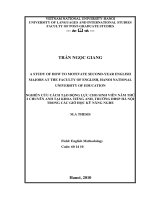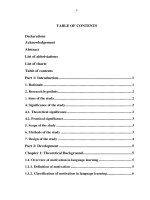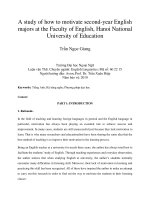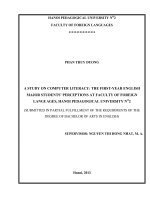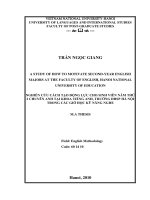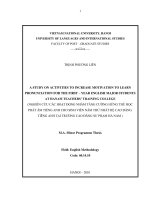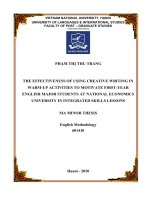A study on activities to motivate first year, non english major students in english speaking lessons at HAUI
Bạn đang xem bản rút gọn của tài liệu. Xem và tải ngay bản đầy đủ của tài liệu tại đây (1.2 MB, 75 trang )
VIETNAM NATIONAL UNIVERSITY, HANOI
UNIVERSITY OF LANGUAGES AND INTERNATIONAL STUDIES
FACULTY OF POST- GRADUATE STUDIES
********************
QUÀNG THỊ BÍCH NGỌC
A STUDY ON ACTIVITIES TO MOTIVATE FIRST-YEAR,
NON-ENGLISH MAJOR STUDENTS IN ENGLISH SPEAKING
LESSONS AT HAUI
Nghiên cứu về các hoạt động được sử dụng để thúc đẩy sinh viên
năm thứ nhất không chuyên tiếng Anh trong các bài học nói
tiếng Anh tại trường Đại Học Công Nghiệp Hà Nội
M.A. MINOR PROGRAMME THESIS
Field: English Teaching Methodology
Code: 60140111
HANOI – 2017
VIETNAM NATIONAL UNIVERSITY, HANOI
UNIVERSITY OF LANGUAGES AND INTERNATIONAL STUDIES
FACULTY OF POST- GRADUATE STUDIES
********************
QUÀNG THỊ BÍCH NGỌC
A STUDY ON ACTIVITIES TO MOTIVATE FIRST-YEAR,
NON-ENGLISH MAJOR STUDENTS IN ENGLISH SPEAKING
LESSONS AT HAUI
Nghiên cứu về các hoạt động được sử dụng để thúc đẩy sinh viên
năm thứ nhất không chuyên tiếng Anh trong các bài học nói
tiếng Anh tại trường Đại Học Công Nghiệp Hà Nội
M.A. MINOR PROGRAMME THESIS
Field: English Teaching Methodology
Code: 60140111
Supervisior: Dr. Đỗ Tuấn Minh
HANOI – 2017
DECLARATION
I, Quang Thi Bich Ngoc, hereby certify that my thesis submitted for the
Faculty of Post- Graduate Studies, University of Languages and International
Studies, Vietnam National University, apart from the help recognized, is my own
work. The substance of this thesis has not, wholly or in part, been summited for a
degree to any other formal course of study.
Hanoi, 2017
Signature
Quang Thi Bich Ngoc
i
ACKNOWLEDGEMENTS
First and foremost, I would like to express my special and sincere thanks to
my supervisors, Dr. Do Tuan Minh, who gave me enthusiastic instructions, precious
support and critical feedback on the construction of the study. This has always been
one of decisive factors in the completion of this thesis.
Second, I also express my profound gratitude to all doctors, lectures and staff
members of the Faculty of Postgraduate Studies, University of Foreign Languages
and International Studies, Vietnam National University, Hanoi for their valuable
lectures and useful advice that are a great help to fulfill the study.
Next, I would like to send my deep sense of thanks to the teachers and the
first- year students of Non- major English Division- Faculty of Foreign LanguageHanoi University of Industry for their cooperation and the valuable information they
provided in my research field.
Furthermore, I would like to send my heartfelt gratitude to my family and all
of my friends who have great source of endless care and support.
Last but not least, I am also thankful to many writers whose important ideas
and notions are exploited and developed in the study.
ii
ABSTRACT
Modern teaching methods of foreign languages count on involving the use
of different organizational forms of activities which support such a development.
The way teachers organize these activities and perceive the individual steps
connected with the organization of activities may essentially influence the eventual
efficiency of the activity and the consequent development of speaking skills. In
other words, motivated activities are essentially provided to for the needs of
teaching English to communicate successfully.
In fact, there a many problems for teachers and students in applying these
communicative activities to enhance speaking skills for first year students at Nonmajor English Division- Faculty of Foreign Language of Hanoi University of
Industry. Therefore, the research approach undertaken by this study combined
between qualitative and quantitative methods. To seek answers for the issue, data
elicited through survey questionnaires and classroom observation from 150 firstyear, non-major English students and 30 teachers at NED were collected and 15
English lessons are observed and analyzed in the forms of frequency, percentage,
charts and tables. Findings from the research show the real situation of teaching and
learning speaking skill as well indicate the most frequent, effective activities are
applied at NED. According to the basic findings, some suggested communicative
activities are presented with appropriate samples in the part of recommendation of
this study. Then some suggestions for teachers while using the activities are also
given.
iii
TABLE OF CONTENTS
DECLARATION ........................................................................................................ I
ACKNOWLEDGEMENTS ....................................................................................... II
ABSTRACT ..............................................................................................................III
TABLE OF CONTENTS ......................................................................................... IV
LIST OF TABLE AND FIGURES ......................................................................... VII
PART A: INTRODUCTION ......................................................................................1
1, Rationale ..........................................................................................................1
2. Aims of study and research questions .............................................................2
3. Significance of the study .................................................................................2
4. Scope of the study ............................................................................................3
5. Method of the study .........................................................................................3
6. Design of the study ..........................................................................................4
PART B: DEVELOPMENT .......................................................................................5
CHAPTER 1: LITERATURE REVIEW ....................................................................5
1.0. Background of speaking ...............................................................................5
1.1. Relation between activities and communicative activities. ..........................5
1.1.1 Communicative language teaching approach .............................................6
1.1.2.. Communicative activities .........................................................................8
1.1.2.1. Definition of communicative activities ..................................................8
1.1.2.2. Features of communicative activities .....................................................9
1.1.2.3. Purposes of communicative activities ..................................................10
1.1.2.4. Sample communicative activities .........................................................11
1.2. Motivation ...................................................................................................16
1.2.1. Definition of motivation. .........................................................................16
1.2.2. Dornyei's (1994a) extended framework ..................................................16
CHAPTER 2: METHODOLOGY ............................................................................20
2.1. Research method .........................................................................................20
2.1.1. Research setting .......................................................................................20
2.1.2. Subjects ....................................................................................................21
2.1.3. Participants...............................................................................................22
2.2. Research instruments ..................................................................................23
2.3. Data collection ............................................................................................23
2.4. Data analysis ...............................................................................................23
2.5. Summary .....................................................................................................24
CHAPTER 3: FINDINGS AND DISCUSSION ......................................................25
3.1.
Data analysis ...........................................................................................25
iv
3.1.1.
3.2.
3.2.1.
3.2.2.
3.3.
Results of teachers and students‘ survey questionnaire .........................25
Findings and discussion ..........................................................................35
Findings from classroom observation.....................................................35
Findings from questionnaire survey .......................................................36
Conclusion ..............................................................................................38
CHAPTER 4..............................................................................................................39
IMPLICATIONS AND RECOMENDATION .........................................................39
4.1 Some kinds of effective communicative activities ......................................39
4.1.1 Using songs ...............................................................................................39
4.1.2. Communicative games.............................................................................40
4.1.3. Question and answer ................................................................................42
4.1.4. Role play ..................................................................................................43
4.1.5. Class discussion .......................................................................................44
4.2. Some considerations and suggestions on using communicative activities .45
4.3. Limitations and suggestions for further research .......................................47
4.4. Conclusion ..................................................................................................47
REFERENCES ..........................................................................................................49
APPENDIX I ............................................................................................................... I
SURVEY QUESTIONNAIRE (FOR TEACHERS) .................................................. I
APPENDIX II .......................................................................................................... IV
SURVEY QUESTIONNAIRE (FOR STUDENTS)................................................ IV
APPENDIX III ........................................................................................................ VII
CLASSROOM OBSERVATION CHECKLISTS .................................................. VII
APPENDIX IV ......................................................................................................... IX
RESULT FROM CLASSROOM OBSERVATION CHECKLIST ........................ IX
APPENDIX V .......................................................................................................... XI
SAMPLE 1 ............................................................................................................... XI
APPENDIX VI ....................................................................................................... XIII
SAMPLE 2 ............................................................................................................. XIII
v
LIST OF ABBREVIATIONS
CLT: Communicative language teaching
L2: Second language
ESL: English as a second language
ELT: English language teaching
NED: Non- major English Division
FFL: Faculty of Foreign Language
HaUI: Hanoi University of Industry
vi
LIST OF TABLE AND FIGURES
Figure 1: Teachers‘ attitude towards the role of English speaking skills ................. 25
Figure 2: Students‘ attitudes and their feelings towards learning speaking skills .... 26
Figure 3: Teacher‘s assessment towards students‘ speaking ability ......................... 27
Figure 4: Possible factors to motivate students speaking in classroom .................... 28
Figure 5: Teacher‘s viewpoints about the reason why students afraid of
speaking and student‘s actual difficulties in speaking English ....................... 29
Figure 6: Teachers' attitudes towards activities in the textbook ................................ 30
Figure 7: Teachers‘ time to use communicative activities and the frequent forms
that they usually organize.......................................................................................... 31
Figure 8: Teachers' kinds of communicate activity applied in lesson and students‘
activity favorites ........................................................................................................ 32
Table 0: Components of foreign language learning motivation (Dornyei, 1994a:
280)………………………………………………………………………………...17
Table 1: Teachers‘ difficulties in applying communicative activities ........................ 32
Table 2: Students‘ difficulties in practicing communicative activities. .................... 33
vii
PART A: INTRODUCTION
1, Rationale
As for Vietnamese, English communicative skill is important because
Vietnam is one of the members of many international organizations such as
ASEAN, WTO and UNESCO. Besides, Vietnam currently has welcomed a number
of foreign visitors and businessmen to investigate develop a lot of big companies
and create great working opportunities for thousands of Vietnamese workers.
Furthermore, the needs of studying abroad and working in another country also
increase for years. Briefly, ―speaking skill is an essential process for learning
English. Performances through speaking are an indicator of success in career and
finally in life‖ (Nunan, 1991). Thus, it is essential to renovate and adapt the suitable
teaching English methods in every classroom.
Admittedly, as regards to the development of speaking skills during a
teaching- learning process, ―most lessons of English are carried out through teachercentered approaches, some teacher have been found to focus on language teaching
based on grammar instead of exposing the learners to language teaching‖ (Nunan,
2004). ―Teacher‘s teaching of grammar only and involving the learners in
communicative English often give a negative impression to students‖ (Ruso, 2007).
Thus, ―there are recommended activities to aid the acquisition, storage, retrieval,
and use of information which have been proved to make learning easier, faster,
enjoyable, self- directed, effective and transferable to new situations‖ (Oxford,
1990). Therefore, teachers should benefit from some approaches by using their
techniques and some good activities to help students master their speaking skills. In
fact, to motivate student effectively, there are a number of factors for instance, the
number of interlocutors, designing activities, interaction patterns, an amount of
information processed, time span, teacher and student, but it is impossible to discuss
all the factors related to this process in the thesis; therefore, a concentration will be
focused only on the effective organization of some communicative activities. This
1
study, therefore, tries to find out applicability of some potential activities in
teaching speaking skills and some suggestions used to create English speaking
lessons with full of energy and a great deal of motivation for first-year, non-English
major students at Hanoi University of Industry.
Briefly, all of the problems mentioned above have studied further on ―A
study on activities to motivate first- year, non- English major students in English
speaking lessons at HaUI”
2. Aims of study and research questions
This study aimed to address the following issues:
Investigating the importance of and the difficulties in applying activities in
teaching speaking process to non- English major students in Vietnam in
general.
Discovering the applicability of some useful activities to improve English
speaking skills for first year, non-English major students in Hanoi University
of Industry.
In order to fulfil these aims, the study focuses on answering the research questions
1, What are the most frequently used activities to motivate students at FFLHaUI in speaking lessons?
2, To what extent, are these activities effective in motivating students at
FFL- HaUI?
3. Significance of the study
As studying on the effective activities and motivation for students in
speaking skills, this work would be benefit for the target population, their English
teacher and other interested in the field.
In the first place, as the first- year student, most of them have to face with the
new lifestyle in their universities, and then their unconfident feelings of studying
with new teachers and friends are expected to be concerned. This study is conducted
with a hope to provide the friendly study environment for them and help students
can speak English naturally and confidently.
2
As for English teachers, the problems which teachers frequently concern
about are exploring the effective activities to motivate their students in speaking
English lessons. Several activities are used during lessons to help and guide
students in speaking skills such as role play, storytelling, reporting, and interview.
Each activity will have various impacts on developing speaking skills for a group of
particular students, but not for everyone. Hence, it is very difficult to clarify the best
activities applied for the first- year, non-English major students in FFL to attain the
best result in a long-term studying. However, they could base on the results of this
work to further understand their students‘ difficulties and it is more compatible and
constructive for their students‘ motivation by improve better teaching methods.
Last but not least, regarding the researchers who are interested in the same or
related field, the researcher hope this paper could work as a reliable source of
reference and a basis for them to develop their works from.
4. Scope of the study
It would be too ambitious for this minor thesis to cover all aspects of all
factors in teaching and learning English speaking. Thus, this study only focused on
some useful activities that motivate non- English major students of HaUI and how
well the teachers of FFL apply them in their English lessons.
5. Method of the study
The methods conducted in this study to find out the answers to the aim of
research questions are both qualitative and quantitative analyses.
Questionnaires and classroom observations are utilized to collect data for the
whole paper. A survey is done by delivering a questionnaire to 30 teachers of FFL
and another questionnaire to 150 first-year, non- English major students at HaUI
who are being taught speaking skills under the process-based approach. After
completing questionnaires, 15 speaking lessons will be observed to build a stable
reliability for this study in term of effectiveness of activities applied in English
lessons. Briefly, all the collected information and data are then analyzed and
discussed, for quantitative analysis, frequency, charts, percentage, tables were
3
published. On the other hand, qualitative data were produced from class observation
checklist.
6. Design of the study
The thesis comprises of two main parts, part A provides a general introduction,
including the rationale for the research and its aim, significance, scope, research
questions and the design of the thesis. And part B is the development sector
including four chapters as follows:
Chapter 1 is an attempt to review some theoretical background for the study.
Several underlying theories: communicative approach, the background and some
frequently activities, the roles of teacher, some motivation factors are discussed as
well. In addition, the theory of teaching speaking and some point of views on
activities are also presented.
Chapter 2 presents the methodology of the study, including the background
information of the context where the study is conducted, the subjects, the
instruments used to collect data, and the procedures of data collection. Furthermore,
a detailed description of data analysis is presented; and some explanations and
interpretations of the findings of the study are given in this chapter.
Chapter 3 is the conclusion of the study, providing some pedagogical implications.
The limitations of the study as well as some suggestions for further research are also
discussed in this chapter.
To sum up, in the first chapter, the following elements have been presented:
(a) The rationale for the study
(b) Aims of the study
(c) Significance of the study
(d) Scope of the study
(e) Methods of the study
(f) Design of the study
These issues have not only justified the major contents and structures of the study
but will also work as the guidelines for the rest of the paper.
4
PART B: DEVELOPMENT
CHAPTER 1: LITERATURE REVIEW
1.0. Background of speaking
The well-paid attention to the theoretical background of speaking will determine the
position of speaking skill among the other skills and to analyze the elements that
speaking as a skill includes. The following part will present the theory of
communicative language teaching approach and communicative activities will be
focused in this part. Finally, some activities in which speaking skills can be
developed wi ll be shown.
Speaking is "the process of building and sharing meaning through the use of verbal
and non-verbal symbols, in a variety of contexts‖ based on Chaney (1998, 13). In
other words, speaking means conveying the message through the words of mouth.
This skill is also called ―Oral Skill‖ or ―Communicative Skill‖. Harmer (2001)
Gower et al. (1995, 99-100) indicated that from the communicative point of view,
speaking has many different aspects including two principal categories as accuracy
and fluency while Martin Bygate, Speaking (1987), whose theoretical inputs
concerning the elements of speaking will be analyzed into two aspects- knowledge
of the language, and skill in using this knowledge. He views the skill as including
two elements: production skills and interaction skills, both of which can be affected
by two conditions: firstly, processing conditions, taking into consideration the fact
that ‗a speech takes place under the pressure of time‘; secondly, reciprocity
conditions connected with a mutual relationship between the interlocutors (Bygate
1987, 7).
Despite its importance, for many years, teaching speaking has been undervalued and
English language teachers have continued to teach speaking just as a repetition of
drills or memorization of dialogues. However, today's world requires that the goal
of teaching speaking should improve students' communicative skills, because, only
in that way, students can express themselves and proficient at social and cultural
rules appropriate in each communicative circumstance.
5
1.1. Relation between activities and communicative activities.
1.1.1 Communicative language teaching approach
With the importance of English currently, teachers need to seek a significant
method to meet the demand of learners in using this language for communication.
The communicative approach or (CLT) is considered as the best approach for such
purpose. It has attempted to describe theories of language learning processes that
are compatible with the communicative approach. It is interesting to note that
―Language learning will take care of itself‖ (Harmer, 2001:70). Today, it is not
considered as a method but as an approach for teaching based on the idea that
language learning means learning how to master the language to achieve a better
communication outside the classroom. CLT developed because of the limitations of
the previous methods, it primarily focuses on the ability to communicate and
interact which was absent in the other methods. It is mainly based on the theory of
communicative competence that comprises grammatical, sociolinguistic, discourse
and strategic competence.
Communicative language teaching (CLT) begins with Chomsky (as cited in
Manner. 1985) mentions that native speakers know all the rules. With this
knowledge, the native speaker can create an infinite number of sentences. This is
called grammatical knowledge competence. However, Dell Hymes (as cited in
Harmer. 1984) disagrees with him. He argues that Chomsky misses some important
points. Native speaker knowing all the rules is not enough because it cannot explain
all that native speakers‘ knowledge; they need to know the functions of language as
well. Hymes coined the concept called communicative competence.
Hymes (as cited in Harmer, 1984, 13-14) separates native speakers‘
knowledge on language into four parts. First, systematic potential, this is a lot
similar to Chomsky‘s original competence. The native speaker has system that can
produce unlimited language; second, appropriacy- the native speaker knows the
appropriateness of using language in a given situation; third, occurrence- the native
speaker knows what language is commonly used. If the native speakers use a
6
common piece of language, it will be clear and understandable. The last one is
feasibility, the native speaker knows if something is possible to use in a language.
For example, native speakers know that using too many adjectives does not make
sense when producing language even though there is no rule to limit how many
adjectives can be used before a noun.
The theory of communicative competence has gone through a serious
development so far Brown (1994), He refers to several theories of communicative
competence as they developed through periods of time. It has been the philosophy
of communicative language teaching (CLT) for many years to teach foreign
languages through communicative approach which focuses ‗on speaking and
listening skills, on writing for specific communicative purposes, and on authentic
reading texts‘ (p.226).
The most important features of CLT then Brown defines by means of four
characteristics:
a) Classroom goals are focused on all of the components of communicative
competence and not restricted to grammatical or linguistic competence;
b) Language techniques are designed to engage learners in the pragmatic,
authentic,
functional
use
of
language
for
meaningful
purposes.
Organizational language forms are not the central focus but rather aspects of
language that enable the learners to accomplish those purposes.
c) Fluency and accuracy are seen as complementary principles underlying
communicative techniques. At times fluency may have to take on more
importance than accuracy in order to keep learners meaningfully engaged in
language use.
d) In the communicative classroom, students ultimately have to use the
language, productively and receptively, in unrehearsed context. (Brown
1994, 245)
Nevertheless, as Brown suggests, the newest views are probably best
captured by Lyle F. Bachman (1990) in his schematization of what Bachman calls
7
‗language competence‘ (Brown 1994, 227-229). According to Bachman (1994, 84),
communicative competence, ‗communicative language ability‘ (CLA), includes two
basic aspects - firstly, knowledge, competence in the language, and, secondly, the
capacity for implementing or using the competence. Bachman proposes three
components that in his view ‗communicative language ability‘ framework includes,
they are: language competence, strategic competence, and psychological
mechanisms.
Bachman divides language competence into two categories: organizational
and pragmatic competence. Organizational competence, further splitting into
grammatical and textual competence, presents those abilities involved in
controlling the formal structure of language for producing or recognizing
grammatically correct sentences, comprehending their propositional content, and
ordering them to form texts. (Bachman 1994, 87)
In a nutshell, communicative language teaching has based on different
characteristics, most researchers agree on the need for the communicative
competence to support learning and make the classroom interaction successful. A
classroom communicative competence- the philosophy of communicative language
teaching as Brown stated is essential in order for the second language students to
participate in and learn from their classroom experience.
Briefly, in present day, many linguistics and teachers agree on that students learn to
speak in the second language by "interacting". Communicative language teaching
and collaborative learning serve best for this aim. Communicative language
teaching is based on real-life situations that require communication. By using this
method in classes, students will have the opportunity of communicating with each
other in the target language.
1.1.2.. Communicative activities
1.1.2.1. Definition of communicative activities
Communicative activities refers to the classroom activities that provide a
genuine information gap and make it possible for language learners to communicate
8
with target language in Communicative Language Teaching Approaches (Liao,
2000). In other words, communicative activities are activities that give students
both a desire to communicate and a purpose which involve them in a varied use of
language. They have real purposes: to find information, to break down barriers, to
talk about oneself, and to learn about the culture. Even when a lesson is focused on
developing reading or writing skills, communicative activities should be integrated
into the lesson.
Communicative activities are fluency-based activities (Tait, S., 2001). While
such activities may involve students to practice a particular grammatical form, they
are likely to do more than this. The key element is that the activity is based on a
realistic situation. This could be anything from an encounter in a department store,
to a group of friends discussing holiday plans, etc. Within this kind of context,
students should be required to negotiate for meaning. This is likely to require
multiple turn taking.
1.1.2.2. Features of communicative activities
Savignon (2001) claims that ―the problem at present is that some of the
activities being introduced as communicative activities are not communicative at all
but structure drills in disguise‖. Thus many teachers may think that the activities
they design and use in class are communicative, but actually they are not. Therefore
the features that make a real communicative activity should be focused on. Based
on related views about communicative activities, Sun & Cheng (2000) summarizes
three common features as follows:
- Communicative activities are task-based. Task-based English teaching
concentrates on communicative tasks that learners need to engage in outside the
classroom.
- Communicative activities are learner-centered. The emphasis of teaching
activity is on students‘ initiation and interaction. Students are expected to
participate in the activities as real people and take responsibility for their learning.
9
- Communicative activities emphasize the use of authentic language input
and the teacher‘s native or near native language competence in order to produce
communication in the classroom. We can represent the distinguishing features
between the two types of activities in the following ways:
Communicative activities
Non-communicative activities
No communicative purpose
No desire to communicate
Form not content
One language item
Teacher intervention
Materials control
A communicative purpose
A desire to communicate
Content not form
Variety of language
No teacher intervention
No materials control
1.1.2.3. Purposes of communicative activities
The aim of communicative activities is to encourage purposeful and
meaningful interaction between learners. Communicative tasks are created so
learners will have a goal or reason for speaking: they can bridge an information and
opinion gap and can ask for or provide real information, or find out about their
friends‘ opinions. Communicative activities can motivate the classroom and prepare
the learners for real- life interaction (Gower. Phillips & Walters. 2005). Harmer
(2007) has the same opinion that the characteristics of truly communicative
activities encourage learners to use language. Learners are motivated to
communicate to achieve a goal. Their aim is to focus on what to say not the form
being used, and they will have to deal with a variety of language structures not just
one language structure.
Littlewood (1991) concludes the purpose of communicative activities as
follows:
-
Communicative activities provide whole-task practice through many kinds of
communicative activities in order to suit the learners‘ levels of ability.
-
Communicative activities improve motivation. The learner‘s ultimate
objective is to take part in communication with others. The more students see
10
their classroom learning related to their objective, the more their motivation
increase.
-
Communicative activities allow natural learning. Many aspects of language
learning can happen only through natural processes which work when the
learner is involved in using the language for communication. That is why
communicative activities are a vital part of the total learning process.
In a nutshell, communicative activities can create a context which
supports learning, create positive personal relationships among the learners and
between learners and the teacher, which encourages individuals to learn better.
1.1.2.4. Sample communicative activities
Communicative activities are dealt with a large number of methodology books and
their classification is distinguished according to each author‘s point of view.
However, all of them mention the same or similar communicative tasks but in
different extent. Here are some types of typical communicative activities.
1.1.2.4.1 Information gap activities
Information gap activities are described by Thornbury (2005) who claims that in
these kinds of tasks there is a knowledge gap among learners and it can be bridged
by using the language. So, in order to obtain the information, the interactants have
to communicate. Littlewood (1994) labels these activities as functional
communication activities. He emphasizes sharing the information among learners
and its processing. The most common information gap activity is spotting the
differences in the pictures, exchanging personal information, guessing games and
also creating the story based on flashcards shown to the students in random order,
for a few seconds and one flashcard per group only. This makes the students
cooperate and communicate with each other to find the lacking information.
1.1.2.4.2. Discussions
Discussions are commonly used activities in speaking lessons. A topic is introduced
to the students via a reading or a listening passage and then they are asked to
discuss a related topic in order to come up with a solution or a response. Celce-
11
Murcia (2001) mentions that students need to be reminded that each person within a
group should have a specific responsibility in the discussion – either keeping time,
taking notes or reporting the results made by the group members.
1.1.2.4.3. Role plays
A widely spread and one of the best communicative activities is a role play which
trains students in the classroom to deal with unpredictable real-life conversation in
an English speaking environment. Ladousse (1987) points out the special reasons
for using the role play in the lessons. It puts students in situations in which they are
required to use and develop language necessary in social relationships and also
helps them to build up their social skills. Using role plays is useful especially while
teaching shy students who have difficulty to participate in conversation about them.
Through this activity they are put into various roles and no longer feel that their
own personality is implicated. A role play is an essential communicative activity
which develops fluency, promotes interaction in the classroom and increases
motivation.
1.1.2.4.4. Class surveys
A class survey is an activity where all the learners in the group need to ask each
other questions to find information, which they then need to analyze and report back
to the class. Doing surveys can be a useful way of getting students to interact,
produce question forms, collect and analyze real information. In the classroom,
class surveys can have various aims and functions: as warmers, as ice-breakers for
new classes, as pre-reading activities, to provide freer practice of target language, as
tasks etc. The key qualities of surveys are that they are communicative and
dynamic.
1.1.3. Teacher and students’ role in communicative activities
Before understanding the role of teacher and student in communicative
activities lessons, it is very important to inspect the relationship between teacherstudents and vice versa. Scrivener (2005: 85) made the following diagram to show
clearly how the interaction happens between the teacher and the students.
12
During teacher-learner interaction, the students seek to demonstrate their
speaking and listening skills in front of their teachers that is why latter should
consider his way of interacting which is very crucial in learning and teaching.
According to Harmer (2009) teachers should focus on three things when they talk
with their students. Firstly, they must pay attention to the kind of the language the
students are able to understand, first, teachers should provide an output that is
comprehensible for the level of all the students. Secondly, the teachers must think
about what they will say to their students, hence the teacher speech is as a resource
for learners. Finally, teachers also have to identify the ways in which they will
speak such as the voice, tone and intonation.
On the other hand, many theories of learning maintain that knowledge is
actively constructed and skills improved through interactions between learners as it
is shown in the diagram in figure 2 done by Scrivener (2005: 86). Johnson (1995)
supports that if learner-learner interaction is well-structured and managed, then it
can be an important factor of cognitive development, educational achievement of
13
students and emerging social competencies. It can also develop the learners‘
capacities through collaborative works. Thus, learners will establish social
relationship through this kind of interaction, where the sense of learning community
is promoted and isolation is reduced in the classroom. Naegle Paula (2002: 128)
adds also that ―talking students with their peers about the content of the course is a
powerful way for them to reinforce what they have learned.‖ The teachers then must
encourage such type of interaction between learners because it is the fastest and the
best way, it makes learners active rather than passive participants.
By knowing the teacher- learner and learner- learner interaction, the roles of
the teacher can be categorized from several points of view, for example, according
to the type of the activity, stage of the activity, or the interaction pattern selected for
the particular activity.
Byrne (1991, 13) divides the roles of the teacher according to the type of
interaction activity distinguishing between fluency and accuracy activities. On the
one hand, during fluency activities, the teacher frequently adopts the roles of
stimulator, manager and consultant, reminding that the main reason for taking part
in such activities is to get students to interact, build the activities and to be available
for help and advice if students need and ask for it. On the other hand, the roles that
the teacher carries out during accuracy activities will primarily include the roles of
conductor, organizer and monitor. Teacher‘s main task will therefore be to make
sure that the students know what to practice, and that they practice effectively,
together with organizing the activities and checking while students are performing.
In relation to fluency speaking activities, Harmer (2001, 275-276) mentions
three basic roles that teachers take on including: prompter, participant, and feedback
provider.
14
While taking the role of a prompter, the teacher offers discrete suggestions or
lets students struggle out of a difficult situation (when students get lost, cannot think
of what to say next, lose fluency), which can stop the sense of frustration when
coming to a ‗dead end‘ of language ideas. A teacher acting as a participant prompts
covertly, introduces new information to help the activity along, ensures continuing
students‘ engagement, and generally maintains a creative atmosphere. Harmer
warns that when acting as a participant, the teacher should be careful not to
participate too much, thus dominating the speaking and drawing all the attention to
him or herself. Finally, feedback provider, Harmer says, may inhibit students and
take the communicativeness out of the activity by over-correction; therefore, the
correction should be helpful and get students out of difficult misunderstanding and
hesitations.
15
1.2. Motivation
1.2.1. Definition of motivation.
Many researchers have been conducted and there is much in the research
literature regarding the definition of motivation. All the motivation theories in
general want to explain the fundamental question of why humans behave as they do,
and therefore we cannot assume any simple and straightforward answer.
Motivation is described as the impetus to create and sustain intentions and
goal seeking acts (Ames & Ames, 1989). Burden (1997:119) assumed that ―from a
cognitive perspective, motivation is concerned with such issues as why people
decide to act in certain ways and what factors influence the choice they make. It
also involves decisions as to the amount of effect people are prepared to expand in
attempting to achieve their goals. The role of the teacher thus becomes one of
helping and enabling learners to make suitable decisions"
Dornei (2001:613) defined motivation as ―a general ways of referring to the
antecedents (i.e. the causes and the origins'. He also stated that ―motivation explains
why people decide to do something, how hard they are going to pursue it and how
long they are willing to sustain the activities‖ (2001:7). The author mentioned two
dimensions of human behavior: direction and magnitude (intensity) which
motivation concerns. Motivation is ―the process whereby goal-directed activity is
instigated and sustained‖ (Pintrich& Schunk, 2002).
From the above, it can be deduced that motivation is a psychological trait
which leads people to achieve a goal. Motivation is what drives you to ―behave‖ in
a certain way or to take a particular action.
1.2.2. Dornyei's (1994a) extended framework
L2 motivation (Dornyei, 1994a) that attempted to synthesize various lines of
research by offering an extensive list of motivational components categorized into
three main dimensions, the Language Level, the Learner Level, and the Learning
Situation Level (see Table 1).
16
